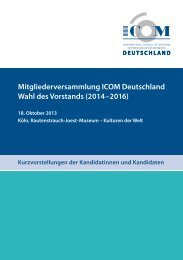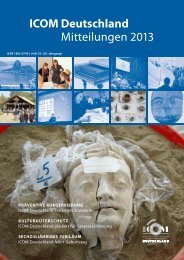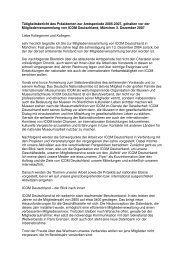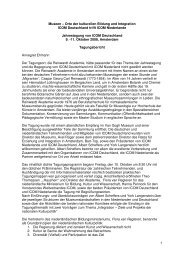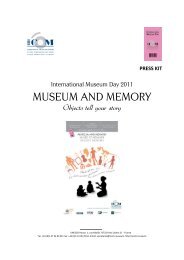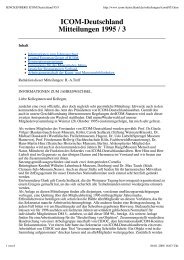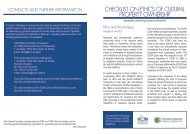ICOM Code of Ethics for Museums - The International Council of ...
ICOM Code of Ethics for Museums - The International Council of ...
ICOM Code of Ethics for Museums - The International Council of ...
You also want an ePaper? Increase the reach of your titles
YUMPU automatically turns print PDFs into web optimized ePapers that Google loves.
4. MUSEUMS pROVIDE OppORTUNITIES FOR THE<br />
AppRECIATION, UNDERSTANDING AND MANAGEMENT<br />
OF THE NATURAl AND CUlTURAl HERITAGE.<br />
principle<br />
<strong>Museums</strong> have an important duty to develop their educational role and attract<br />
wider audiences from the community, locality, or group they serve. Interaction with<br />
the constituent community and promotion <strong>of</strong> their heritage is an integral part <strong>of</strong> the<br />
educational role <strong>of</strong> the museum.<br />
DISplAy & EXHIBITION<br />
4.1 Displays, Exhibitions and<br />
Special Activities<br />
Displays and temporary exhibitions, physical<br />
or electronic, should be in accordance<br />
with the stated mission, policy and purpose<br />
<strong>of</strong> the museum. <strong>The</strong>y should not compromise<br />
either the quality or the proper care and<br />
conservation <strong>of</strong> the collections.<br />
4.2 Interpretation <strong>of</strong> Exhibitions<br />
<strong>Museums</strong> should ensure that the in<strong>for</strong>mation<br />
they present in displays and exhibitions<br />
is well-founded, accurate and gives<br />
appropriate consideration to represented<br />
groups or beliefs.<br />
4.3 Exhibition <strong>of</strong> Sensitive<br />
Materials<br />
Human remains and materials <strong>of</strong> sacred<br />
significance must be displayed in a manner<br />
consistent with pr<strong>of</strong>essional standards<br />
and, where known, taking into account the<br />
interests and beliefs <strong>of</strong> members <strong>of</strong> the<br />
community, ethnic or religious groups from<br />
whom the objects originated. <strong>The</strong>y must<br />
be presented with great tact and respect<br />
<strong>for</strong> the feelings <strong>of</strong> human dignity held by<br />
all peoples.<br />
4.4 Removal from public Display<br />
Requests <strong>for</strong> removal from public display<br />
<strong>of</strong> human remains or material <strong>of</strong> sacred significance<br />
from the originating communities<br />
must be addressed expeditiously with respect<br />
and sensitivity. Requests <strong>for</strong> the return<br />
<strong>of</strong> such material should be addressed similarly.<br />
Museum policies should clearly define<br />
the process <strong>for</strong> responding to such requests.<br />
4.5 Display <strong>of</strong> Unprovenanced<br />
Material<br />
<strong>Museums</strong> should avoid displaying or<br />
otherwise using material <strong>of</strong> questionable<br />
origin or lacking provenance. <strong>The</strong>y should<br />
be aware that such displays or usage can<br />
be seen to condone and contribute to the<br />
illicit trade in cultural property.<br />
OTHER RESOURCES<br />
4.6 publication<br />
In<strong>for</strong>mation published by museums, by<br />
whatever means, should be well-founded,<br />
accurate and give responsible consideration<br />
to the academic disciplines, societies,<br />
or beliefs presented. Museum publications<br />
should not compromise the standards <strong>of</strong><br />
the institution.<br />
4.7 Reproductions<br />
<strong>Museums</strong> should respect the integrity <strong>of</strong><br />
the original when replicas, reproductions,<br />
or copies <strong>of</strong> items in the collection are<br />
made. All such copies should be permanently<br />
marked as facsimiles.<br />
8




